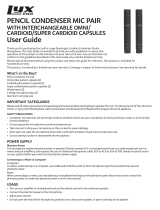
Townsend Labs Sphere L22 Precision Microphone System Guide
7
Chapter 1: Introduction
Thank you for choosing the Sphere L22™ Precision Microphone system as part of your musical
creative process. Developing the Sphere L22 has been a labor of love for those of us at Townsend
Labs, and we hope you enjoy using it as much as we did designing and building it.
At its heart, the Sphere L22 is a precision, high-quality, large-diaphragm condenser microphone. When
combined with the included Townsend Labs Sphere DSP modeling plug-in (VST, AAX, AU, UAD),
it offers numerous advanced features that place it well beyond the capabilities of any currently available
mic. Most notably, it accurately models a wide range of the most sought after vintage and modern
microphones.
Previous mic modeling technologies apply EQ to filter sound from what is essentially a conventional
mic. This is fundamentally the same as using EQ to process a recorded track, which is inherently
limited in how the sound can be affected. In contrast, the Sphere L22 mic has two capsules, each with
its own output, which more completely captures the directional and distance information otherwise
lost with a conventional single-channel mic. This additional information lets the Townsend Labs
Sphere DSP plug-in reconstruct how different mics respond to the soundfield.
Feature Summary
The Sphere L22 Precision Microphone System goes beyond pure mic modeling, and many of its
capabilities have never been possible with previous mic modeling technologies:
• Three-dimensional Modeling - Accurately models a wide range of mics, including complex 3D
polar response, transient response, and proximity effect.
• Re-Mic Recorded Tracks - Select mic type, polar pattern, and all other DSP settings even after
tracking.
• Adjustable Proximity Effect - Lets you leave a mic in place while adjusting the bass response due
to proximity effect.
• Simultaneous Mic Models - Lets you mix multiple virtual mic models from the same physical mic
before or after tracking (phase coherent).
• Stereo - Lets you make coincident stereo recordings with one Sphere L22 mic, and even use different
mic models on the left and right channels.
• Off-Axis Correction - Creates more accurate polar patterns that can be used to reduce bleed, room
coloration, and feedback even after tracking.
• Axis Shift - Virtually rotates the axis of the mic to obtain a more off-axis sound even after tracking.
• Low-Latency DSP Processing - The UAD plug-in version on a Universal Audio Apollo
achieves extremely low latency processing (~1.6 ms round trip at 96 kHz) with guaranteed real-
time performance.
• Wide Range of Plug-In Formats - AAX Native, VST2, VST3, and UAD (Mac and Windows);
Audio Units (Mac only).





















